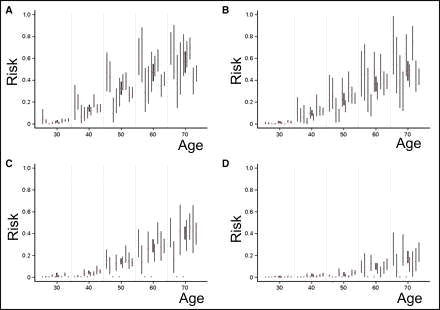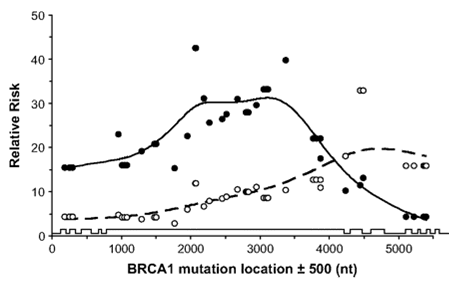|
|
First
Concepts.
WOB
is Optimal
One of the greatest follies of modern medicine is the declaration that cancer is a genetic disease. A genetic disease is caused by an abnormality in an individual's genome. (MedicineNet.com ). Some hereditary diseases, like Huntington’s are associated with a change of one gene. Most hereditary diseases involve more than one gene, and are known as polygenic disorders.
Cancer is regarded as a polygenic disorder. Its evolution
is driven by genetic errors, known as mutations which according to medicine
cause cancer. True, tumor evolution is associated with gene mutations, yet
there is no evidence that these actually cause cancer.
Breast cancer genes: BRCA1 and BRCA2
Recently mutations of two genes associated with breast and ovary cancers were
discovered, BRCA1 and BRCA2, and oncology makes us believe that they cause
cancer, which has never been verified experimentally. At best these mutations
indicate that their carriers are prone to get cancer some time during their
life. Their risk to get cancer is higher than that of the average female population.
Genetic counselors advise young women carrying these mutations to remove their
breasts and save themselves from their poor fate.
Is this advice justified? A meta-analysis of the risk facing these women
was published recently. It indicates that their cumulative risk to get cancer
rises with age . However a closer inspection of the data reveals that the
risk never hits the probability of one, which would mean that all
women would get cancer. According to figure D the cumulative risk does not
exceed 0.4, which means that at least 60% of women carrying BRCA mutations
will neither get breast nor ovarian cancers! Should they still be encouraged
to remove their breasts as a preventive measure?
=======================================================================

(A) Breast cancer risk for BRCA1 carriers, (B) breast
cancer for BRCA2 carriers, (C) ovarian cancer for BRCA1 carriers,
and (D) ovarian cancer for BRCA2 carriers. The cumulative risk estimates
from published studies (thin vertical bars) and the meta-analytic mean (thick
vertical bars, height represents 95% CIs). Within each 10-year age interval,
the published studies are arranged in the following order (left to right):
Ford et al6
and Easton et al,7
Struewing et al,8
Hopper et al,9
Satagopan et al,10,11
Scott et al,12
Antoniou et al,13
King et al,14
Marroni et al,15
and Chen et al.16
An "x" represents not available
Sining Chen, Giovanni Parmigiani Meta-Analysis of BRCA1
and BRCA2 Penetrance
Journal of Clinical Oncology, Vol 25, No 11 (April 10), 2007: pp.
1329-1333
==========================================================================
Penetrance
This observation makes genetic counselors extremely uneasy since it shows
that not every BRCA mutation “causes” cancer. It supports the notion that
cancer might not be a genetic disease. Although these mutations are associated
with cancer they may not cause it. Why then remove the breasts? In order
to save their theory, geneticists conjured the term penetrance:
-- It is the frequency, under given environmental conditions, with which a specific phenotype is expressed by those individuals with a specific genotype. (Annswes.com)
-- A term used in genetics that describes
the extent to which the properties controlled by a gene, its phenotype, will be expressed.
(Wikipedia)
“Expressed” actually means that cancer does not show up and
these women will remain healthy. This conclusion undermines the current
dogma (folly). This is why geneticists adhere to “penetrance”. They claim
that all BRCA mutation carriers are sick even if their cancer did not show
up and their breasts have to be removed.
More on this topic: Beware of the Gene:
Mutation frequencies in BRCA1 gene
The following study indicates that the BRCA1 gene may mutate at different
sites. The figure indicates the risk to get cancer involved with each mutation
type.
=========================================================================================

Relative risks of ovarian and breast cancers in the general Ontario population
for BRCA1 mutations within 500 nucleotides of the position plotted. Ovary
= solid circles and solid line (smoothed); breast = open
circles and dashed line (smoothed). The thin line at the
bottom indicates locations of the 5'-untranslated region and exons 2, 3, and
5–24 according to positions in the cDNA. The long middle span in this
line is exon 11
Harvey A. Risch, John R. McLaughlin, David E. C. Cole, Barry Rosen, Linda
Bradley, Isabel Fan, James Tang, Song Li, Shiyu Zhang, Patricia A. Shaw, Steven
A. Narod
Population BRCA1 and BRCA2 Mutation Frequencies and Cancer Penetrances:
A Kin–Cohort Study in Ontario, Canada
JNCI Journal of the National Cancer Institute 2006 98(23):1694-1706
=============================================================================
Note that the cumulative risk to get breast cancer does not exceed 20%. Thus
80% of women with one of these mutations will never get cancer! Again, as
the title of the study indicates, the authors take refuge in the safe haven
of “penetrance.”
Penetrance is inversely proportional to the resistance to cancer.
Contrary to the fatalistic view of medicine, cancer does not evolve in a helpless
host. From its very beginning patients mobilize healing processes
in order to live with it in peace. Some succeed and will never get cancer
and are collectively regarded as patients with low penetrance. Here they are
regarded as Cancer Yogis, patients with
heightened resistance to cancer. This site attempts to reveal their secret,
and apply it for boosting cancer resistance in patients.
Cancer is more than just the tumor
Cancer is a systemic disease manifested by ongoing cachexia, para-neoplasia,
and a tumor. It is driven by a cachexia and less by the
tumor. The observed mutations do not drive the disease, they accompany it.
They may even represent healing processes in cancer.
More on this topic: Pernicious
cachexia